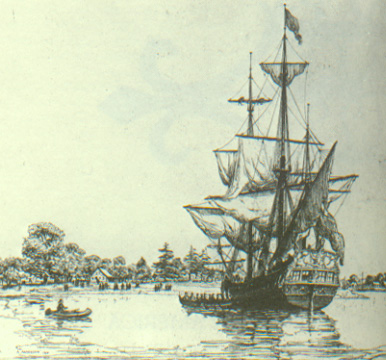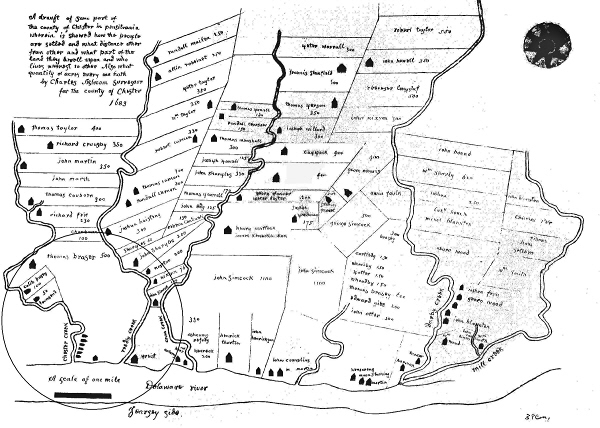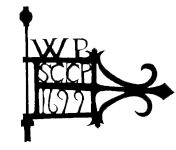1600's
The first European settlers in this area were the Swedes under the leadership of Governor Johann Printz. He arrived in the area in 1643 and built a permanent settlement at Tinicum Island. Some of these colonists settled on plantations located between two creeks; Mesckopenackan (the Indian name for what is now Chester Creek) and Upland Kijlen (The Swedish name for what is now Ridley Creek). The land area between these two waterways was named Upland by the Swedes because the land resembled an area of their homeland of that name.
The settlement of Upland was built around the point where the Chester creek flows into the Delaware River. The plantations mostly grew tobacco for shipment back to Sweden. The person who owned the plantation that covered what is present day Upland was a soldier and bodyguard to Governor Printz named Joran Kyn (Keen). It is not known whether he ever made his home here.
During this period three governments were competing for colonial supremacy on Americas east coast; the Dutch, the Swedish and the English. The Dutch in New Amsterdam (later New York) claimed rights to what they called the South River, The Swedes were already here along with some Finnish settlers who came with them, and the English sought to connect their colonies in New England and Virginia by a presence along the east coast.
We know the Swedes called this area Upland. The Dutch governor of New Amsterdam sent his troops up the river and forced the Swedes to capitulate and rename the area "Oplandt". In September of 1664 English Colonel Nichols captured New Amsterdam from the Dutch and it became "his Majesty's town of New York", under the Duke of York. When the locals heard this, they decided they could rename the area Upland again, and so they did.
Through a series of battles and peace agreements all of the settlements along the river came under the control of the English Crown by 1674. On September 25, 1676 the Duke of York's laws were promulgated as the rule of conduct on the Delaware River, and courts were established, one of which was at Upland.

On March 4, 1681, Charles II, of England signed the great charter which conveyed to William Penn the enormous tract of land now known as Pennsylvania. William Penn came to Pennsylvania on the ship "Welcome" along with about 100 others, mostly members of the Society of Friends (Quakers) from the county of Cheshire in England. Shortly after his arrival at the old Swedish settlement of Upland he changed the name to Chester in honor of the major city in the county of Cheshire. For some time it seems that both names were used to refer to that place, but the creation of Chester County and Chester Township helped to make the town name of Chester stick.
Also in 1681, a group of twelve men in London, England had met to form a stock company (which became known as "the Society of Free Traders") to erect one or more water powered mills in the new colony. The cost of the venture was to be divided among the investors with the profits to be shared according to the investment each made. Caleb Pusey was selected to be the mill manager and agent for the joint venture. Richard Townsend was a builder and millwright and he directed the assembly and testing of a mill in the London area. This prefabricated mill was disassembled and loaded on the ship "Welcome" and was brought out to Upland with William Penn. Upon arrival, the mill was unloaded and barged up the Chester creek.
The location of the mill was decided upon with the help of Thomas Wade, a prominent Quaker who had lived in the area for 7 years. He was well respected by William Penn and he was asked to help Caleb Pusey scout the best location. The decision was made to locate the mill at the head of tidewater on the Chester creek. This would allow the mill and other materials to be floated up the creek to this point and to enable ease of transport of the milled flour and boards down the creek to Chester and beyond.

While still in London, Caleb Pusey had paid for 250 acres of land, of which 100 acres, Caleb's "Landingford Plantation", were laid out along Chester creek in today's Upland Borough. The 50 acres immediately to his east were that of Richard Townsend and to the north and west were the 500 acres belonging to Thomas Brassey. (See above.) These men were counted among William Penn's 450 First Purchasers, and these parcels made up what is today the Borough of Upland. Caleb Pusey is best known in the area now because of his home, built in 1683, which still survives. (See Link.)
In addition to the early landholders there was another reason for the prominence of the present day Upland, which probably caused these men to come to this area in the first place. For years before the arrival of the Europeans, the local Indians had created and used a trading trail which ran from where today's Darby is located, along the general route of the present MacDade Boulevard into the Chester area, where it followed the present 24th Street to today's Upland Avenue. Here it turned down the hill passing the current Kerlin Street and on to Front Street where it turned right and followed close by the Chester creek across the land that later would become Caleb Pusey's "Landingford Plantation", and then made a crossing to the higher ground on the opposite side of the creek.
Dr. Paul Wallace, the Indian expert, sites this Indian trail. "The Indians could here cross over on stones and keep their moccasins dry." This was the main North/South land route at the time and for many years would play an important role in the development of the area.
Caleb Pusey and his partners in the mill chose the site wisely, for wherever there was a mill there had to be a trail so that the farmers and planters could reach it. The Swedes had used this Indian trail, and, when the English settlers came, it was their only way of going by foot or horseback to the south. This trail went down to Marcus Hook, earliest settlement in the state, to Newcastle, now in Delaware, and on to Maryland. The only other way to travel was by boat. So in many of the early Quaker journals there are recitals of the early travels, with occasional mention of stopping at Caleb Pusey’s house at Chester Mills on the way to the Yearly Meeting in Maryland.
With the coming of the English, the stepping stones across Chester Creek could no longer suffice. The court records tell repeatedly that Caleb Pusey was to keep a good plank bridge over the creek so that horses could cross over in safety. But progress came, and in 1706 a new road from the north to the south was finished, and alas, Caleb's Chester Mills and Landingford Plantation were not on the route. The Queen's Road entered Chester from the north along Fifth Street, moved along Market to the Market Square, and turned south over the Third Street bridge. From here on it was called the King's Road. And our present day Borough of Upland and Caleb's Landingford Plantation were not in the limelight until the 19th century industrial boom of the Crozers.
So now, as you can see, the story of the beginnings of our Borough of Upland is tied to the developments and the ownership of the Chester Mills and of the land on which our present community exists.
Caleb Pusey continued to operate and manage the Chester Mills enterprise despite incurring the consequences of numerous hardships. In 1683, the first year of mill operations, the mill and dam were swept away in a violent fall freshet (flood). The mill and dam are rebuilt the following year and successfully operated until they were again the victim of a flash flood in 1687 or 1688. A third mill was erected at a distance of about one-half mile downstream from the location of the second mill. A mill race was constructed which carried the water to the mill from about one mile upstream. The combination of the new location and the mill race protected the mill from damage until the great flood of 1704.
 During these years of trouble with nature the expenses of the repairs were so great that the outlay far exceeded the earnings of the mill and Pusey borrowed money from time to time to pay for the improvements. Many of the original partners had refused to pay more and through court settlements and forced sales by 1695 there were only three partners left; William Penn, Samuel Carpenter (merchant of Philadelphia) and Caleb Pusey. But now the venture was beginning to be profitable. In 1699 William Penn came to midday meal at Caleb Pusey's house and the visit was commemorated by the presentation of a weathervane to the mill operators. The weathervane is one of the most famous 17th century Pennsylvania icons and shows the initials WP SC - CP and 1699. A small copy is on display at the Crozer Schoolhouse Museum in Upland, and the original can be seen at the Atwater-Kent Museum in Philadelphia.
During these years of trouble with nature the expenses of the repairs were so great that the outlay far exceeded the earnings of the mill and Pusey borrowed money from time to time to pay for the improvements. Many of the original partners had refused to pay more and through court settlements and forced sales by 1695 there were only three partners left; William Penn, Samuel Carpenter (merchant of Philadelphia) and Caleb Pusey. But now the venture was beginning to be profitable. In 1699 William Penn came to midday meal at Caleb Pusey's house and the visit was commemorated by the presentation of a weathervane to the mill operators. The weathervane is one of the most famous 17th century Pennsylvania icons and shows the initials WP SC - CP and 1699. A small copy is on display at the Crozer Schoolhouse Museum in Upland, and the original can be seen at the Atwater-Kent Museum in Philadelphia.

